In this collection of recipes for Live Naturally magazine, purple foods was the color of the day. Why purple? Whether it’s kale with purple tipped leaves or Peruvian purple potatoes, that deep rich color means more anthocyanins. What are anthocyanins? They are the pigments that give fall leaves their color. In food, they are often associated with what is called superfoods, typically high in antioxidants and easily found from their bright red, blue and purple colors. They tout a number of benefits for your health, reducing the risk of cancer, heart disease, brain disorders and assisting in blood-sugar balance.
When my editor gave me this assignment, it was fall–the season of anthycyanins–a fabulous time to find seasonal purple foods for the winter issue Live Naturally (download the Winter 2018 issue here). This isn’t always the case, sometimes for instance, I am working on Thanksgiving in July. This time everything was lined up for easy shopping. My list included: purple cabbage, purple dried prunes, purple kale, blackberries, beets, purple potatoes and purple grapes.
The following are my cooking notes for the Purple Cabbage Strudel. These are my behind the scenes notes that didn’t get in the magazine. The rest of the recipes are below for you to download.
Recipe: Purple Cabbage Strudel
Inspiration: Every Thanksgiving my family serves roasted duck with the traditional Thanksgiving 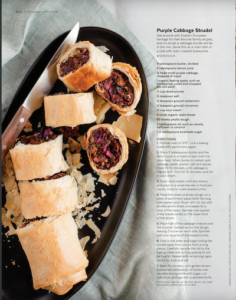 turkey. this means the duck needs it’s own gravy and side dishes. The tangy sour and sweet flavors of pickled purple cabbage cuts through the fattiness of the duck.
turkey. this means the duck needs it’s own gravy and side dishes. The tangy sour and sweet flavors of pickled purple cabbage cuts through the fattiness of the duck.
Yes, you can buy it in jars in the supermarket, but it’s just not the same. For this recipe, I imagined what about putting the purple cabbage center plate as a main dish?
Tips: If you try this recipe, there are a few things to keep in mind as you work on it.
- Cut the red cabbage as thinly as possible. If you have a steady hand and good eyesight, try it by hand. If you are more like the rest of us for fine culinary cutting, use a mandolin or a large shredder with a single blade. it’s important because you will be rolling the cabbage up in a very delicate phyllo pastry and large chunks of cabbage will tear the dough.
- Have everything ready to go. In French cooking they call this mise en place (everything in its place). French cuisine has a work for everything, but basically it’s a fancy term for be prepared. First, let’s assume we are all using frozen phyllo. If you aren’t bless you. If frozen, thaw it out the day or night before in the refrigerator. Phyllo dough is notorious for drying out, which means it’s doesn’t hold well or wait for you to get your act together in the kitchen. So, make sure the cooked purple cabbage has cooled to a tepid temperature. Have your bread crumbs ready. And, most of all use the plastic sheet that came in the box as the first layer of protection, sandwich the the pastry in between two damp kitchen towels (underneath and on top), and have the oil (or butter) and a pastry brush within reach.
- Be patient and forgiving of yourself. As I mentioned, phyllo pastry is very delicate. I guarantee it will tear, but that’s OK. First oil every single inch of the dough, starting with the outside edges (they dries more quickly). If it tears, don’t freak out. Use the pastry brush and oil like a Spackle and glue it back together. It won’t matter in the end. I am in such awe of my Greek ancestors who make phyllo dough by hand, somehow I didn’t inherit their finesse, but it’s OK. Be generous with the oil or butter and it will work out.
- Roll tightly. The beauty of anything wrapped in phyllo is the texture when those shards of pastry break up in your mouth (and fall down your shirt or in your lap). This happens because of the separated layers of dough and fat, much like a perfect croissant. To get the perfect crunch, roll tightly in a cylinder, brush with more oil or butter and bake until it’s golden brown.
Click on the image for each purple food recipe from Live Naturally Magazine
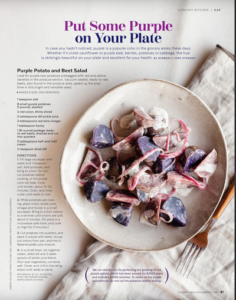
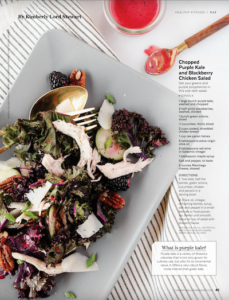
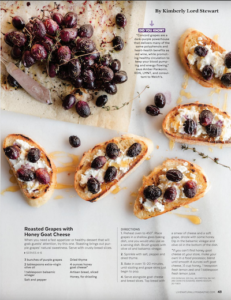


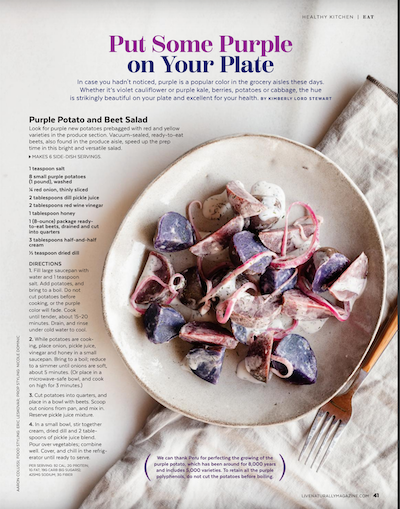

Leave a Comment